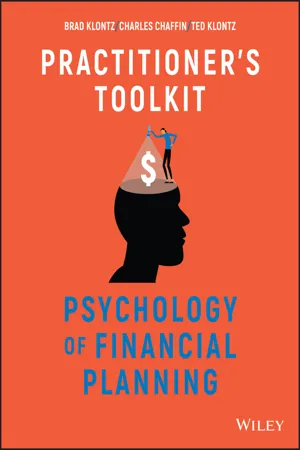
Psychology of Financial Planning, Practitioner's Toolkit
Practitioner's Toolkit
- English
- ePUB (mobile friendly)
- Available on iOS & Android
Psychology of Financial Planning, Practitioner's Toolkit
Practitioner's Toolkit
About This Book
Tools to help financial planners become more effective
Psychology of Financial Planning: Practitioner's Toolkit is a practical, hands-on companion resource to the authors' Psychology of Financial Planning. It brings assessments, reflection and exercises that helps the financial planner better understand their own biases and behaviors as well as those of their clients. The Practitioner's Toolkit includes exercise related to all of the learning objectives in the Psychology of Financial Planning that are found on the CFP® Exam.
This Practitioner's Toolkit offers a collection of tools designed to expand on aspects of the companion book, including assessments and exercises financial planners can use with their clients. It guides readers through the application of concepts explored in the Psychology of Financial Planning and encourages discussion and sharing with clients and members of planning firms.
Readers will also find:
- Tools and strategies to assist the financial planner in understanding client and planner attitudes, values, and biases,
- Explorations of multicultural competence, behavioral finance, and helping client's navigate crisis events across a broad range of circumstances and financial planning clients,
- Exercises that focus on resolving common sources of money conflict, avenues to get the client to take action, client goal-setting, and principles of effective communication and facilitating change.
Designed for current and aspiring financial planning professionals and educators in financial planning across roles and business models, The Psychology of Financial Planning: Practitioner's Toolkit is a must-have on bookshelves of practitioners from firms large and small.
Frequently asked questions
Information
Table of contents
- Cover
- Table of Contents
- Title Page
- Copyright
- Introduction
- Chapter 1: Client Values and Goals
- Chapter 2: Multicultural Competence in Financial Planning
- Chapter 3: Financial Flashpoints: Exploring a Client's Financial Background
- Chapter 4: Money Scripts: Exploring a Client's Beliefs About Money
- Chapter 5: Financial Behaviors and Outcomes
- Chapter 6: Principles of Effective Communication
- Chapter 7: Client and Planner Attitudes, Values, and Biases
- Chapter 8: Sources of Money Conflict: Working with Couples and Families
- Chapter 9: Helping Clients Navigate Crisis Events
- Chapter 10: Principles of Counseling in Financial Planning Practice
- Chapter 11: Behavioral Finance: Understanding Cognitive Biases and Heuristics … and What to Do About Them
- Chapter 12: Getting the Client to Take Action
- Going Forward
- In Closing
- Index
- End User License Agreement